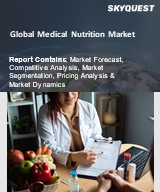
Report ID: SQMIG35D2252

Report ID:
SQMIG35D2252 |
Region:
Global |
Published Date: May, 2024
Pages:
218
|
Tables:
125 |
Figures:
86
Drivers
The Rising Senior Population Worldwide
Rising Healthcare Expenditure
Treating Acute Malnutrition in Non-Hospital Settings
Dietary Shifts and the Growth of Medical Nutrition Industry
Restraints
Side Effects and Complications
High Production Costs
Low Exposure Towards Nutrition
Adapting to Evolving Dietary Guidelines in Medical Nutrition Industry
Our industry expert will work with you to provide you with customized data in a short amount of time.
REQUEST FREE CUSTOMIZATIONWant to customize this report? This report can be personalized according to your needs. Our analysts and industry experts will work directly with you to understand your requirements and provide you with customized data in a short amount of time. We offer $1000 worth of FREE customization at the time of purchase.

Report ID: SQMIG35D2252